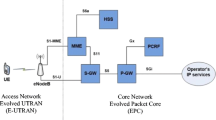Abstract
In the last years, cellular operators have experienced a rapid growth of mobile broadband subscribers and traffic volume per subscriber. At the same time, operators are moving from a single to a multi-service offering by adding new services such as multimedia telephony and mobile-TV. In this challenging scenario, the Quality of Service (QoS) concept provides network and service operators with a set of tools to enable service and subscriber differentiation. This paper presents an overview of the QoS drivers in Long-Term Evolution (LTE) and LTE-Advanced (LTE-A) networks, focusing on their QoS policy control capabilities. Proposals of policy control and management for increasing the QoS in LTE and LTE-A networks are described. This paper also includes a detailed list and analysis of the inputs to the Policy and Charging Rules Function (PCRF) that can be used for policy decision as well as a set of use cases involving the Policy and Charging Control architecture: (1) the analysis of a potential cooperation between the PCRF and a Deep Packet Inspector, and (2) the analysis of a potential interaction between the PCRF and the radio scheduler to provide a consistent end-to-end QoS.








Similar content being viewed by others
References
Akyildiz, I. F., Gutierrez-Estevez, D. M., & Reyes, E. C. (2010). The evolution to 4g cellular systems: Lte-advanced. Physical Communication, 3, 217–244. doi:10.1016/j.phycom.2010.08.001.
Olsson M., & S.S.R.S.F.L.M.C. (2009). SAE and the evolved packet core: Driving the mobile broadband revolution. Amsterdam: Elsevier.
Ekstrom, H. (2009). Qos control in the 3g pp evolved packet system. Communications Magazine, IEEE, 47(2), 76–83. doi:10.1109/MCOM.2009.4785383.
Loureiro, P., Liebsch, M., & Schmid, S. (2010). Policy routing architecture for ip flow mobility in 3gpp’s evolved packet core. In GLOBECOM Workshops (GC Wkshps), 2010 IEEE (pp. 2000–2005). doi:10.1109/GLOCOMW.2010.5700295.
Good, R., de Gouveia, F. C., Ventura, N., & Magedanz, T. (2010). Session-based end-to-end policy control in 3g pp evolved packet system. Interantional Journal on Communication System, 23, 861–883. doi:10.1002/dac.v23:6/7.
Sou, S. I., & Lin, C. S. (2011). Spr proxy mechanism for 3g pp policy and charging control system. Computer Networks, 55(17), 3847–3862. doi:10.1016/j.comnet.2011.07.025.
Ouellette, S., Marchand, L., & Pierre, S. (2011). A potential evolution of the policy and charging control/qos architecture for the 3g pp ietf-based evolved packet core. Communications Magazine, IEEE, 49(5), 231–239. doi:10.1109/MCOM.2011.5762822.
Gomez, G., Lorca, J., Garcia, R., & Perez, Q. (2013). Towards a qoe-driven resource control in lte and lte-a networks. Journal of Computer Networks and Communications, 2013(505910), 15. doi:10.1155/2013/505910.
Alasti, M., Neekzad, B., Hui, J., & Vannithamby, R. (2010). Quality of service in wimax and lte networks [topics in wireless communications]. Communications Magazine, IEEE, 48(5), 104–111. doi:10.1109/MCOM.2010.5458370.
3GPP. (2013). Ts 23.203, policy and charging control architecture.
Balbas, J. J., Rommer, S., & Stenfelt, J. (2009). Policy and charging control in the evolved packet system. Communications Magazine, IEEE, 47(2), 68–74. doi:10.1109/MCOM.2009.4785382.
Damic, D. (2012). Challenges in deploying the 3gpp policy and charging control framework. In Telecommunications Forum (TELFOR), 2012 20th (pp. 170–173). doi:10.1109/TELFOR.2012.6419175.
3GPP. (2013). Ts 29.212, policy and charging control (pcc); reference points.
Nuaymi, L., Sato, I., & Bouabdallah, A. (2012). Improving radio resource usage with suitable policy and charging control in lte. In Next generation mobile applications, services and technologies (NGMAST), 2012 6th international conference on (pp. 158–163). doi:10.1109/NGMAST.2012.26.
Mir, U., & Nuaymi, L. (2012). Comparison of policy realization strategies for lte networks. In Vehicular Technology Conference (VTC Fall), 2012 IEEE (pp. 1–6). doi:10.1109/VTCFall.2012.6399314.
Gómez, G., Poncela González, J., Aguayo-Torres, M., & Entrambasaguas Munoz, J. (2010). Qos modeling for end-to-end performance evaluation over networks with wireless access. EURASIP Journal on Wireless Communications and Networking 2010, 2010(831707). doi:10.1155/2010/831707.
Acknowledgments
This work has been partially supported by the Junta de Andaluca (Proyecto de Excelencia TIC 06897) and by the Spanish Government (TEC2010-18451).
Author information
Authors and Affiliations
Corresponding author
Rights and permissions
About this article
Cite this article
Gómez, G., Pérez, Q., Lorca, J. et al. Quality of Service Drivers in LTE and LTE-A Networks. Wireless Pers Commun 75, 1079–1097 (2014). https://doi.org/10.1007/s11277-013-1409-0
Published:
Issue Date:
DOI: https://doi.org/10.1007/s11277-013-1409-0




